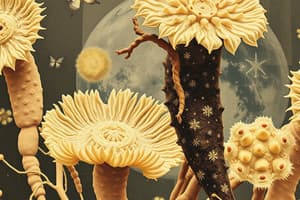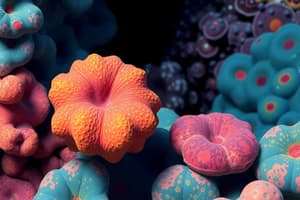Podcast
Questions and Answers
What distinguishes sponges from protozoans?
What distinguishes sponges from protozoans?
- Sponges have a digestive tract.
- Sponges are organized on the cellular level. (correct)
- Sponges have well-defined tissues.
- Sponges are unicellular.
What material are the spicules in Class Calcarea primarily made of?
What material are the spicules in Class Calcarea primarily made of?
- Keratin
- Calcium carbonate (correct)
- Silica
- Collagen
Which class of sponges contains silicious spicules that are usually 6-rayed?
Which class of sponges contains silicious spicules that are usually 6-rayed?
- Class Sclerosponeae
- Class Demospongeae
- Class Calcarea
- Class Hyalospongia (correct)
Which of the following statements about sponges is false?
Which of the following statements about sponges is false?
What type of internal skeleton might be found in Class Demospongeae?
What type of internal skeleton might be found in Class Demospongeae?
Which class of sponges is known to have a hard internal skeleton composed of aragonite?
Which class of sponges is known to have a hard internal skeleton composed of aragonite?
Flashcards are hidden until you start studying
Study Notes
Overview of Phylum Porifera
- Comprises animals known as sponges, representing the simplest form of multicellular life.
- Body organization on a cellular level, differing from unicellular protozoans, where one cell performs all life functions.
- Body structure features a system of canals for water intake and waste expulsion.
- Possesses a skeleton formed by spicules (hard structures) or spongin fibers, or a combination of both.
- Lacks true tissues and a digestive tract, highlighting its simple anatomical structure.
Classes of Phylum Porifera
-
Class Calcarea
- Known as calcareous sponges.
- Characterized by spicules composed of calcium carbonate.
- Spicules can be one, three, or four-rayed.
-
Class Hyalospongia
- Referred to as glass sponges.
- Distinguished by siliceous spicules, typically featuring six rays.
-
Class Demospongeae
- Internal skeleton composed of silicious materials and/or spongin fibers.
-
Class Sclerosponeae
- Contains species with a hard internal skeleton, often made of aragonite.
- Represents diverse structural adaptations among various sponge species.
Studying That Suits You
Use AI to generate personalized quizzes and flashcards to suit your learning preferences.




